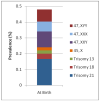Noninvasive prenatal aneuploidy testing of chromosomes 13, 18, 21, X, and Y, using targeted sequencing of polymorphic loci
- PMID: 23108718
- PMCID: PMC3548605
- DOI: 10.1002/pd.3993
Noninvasive prenatal aneuploidy testing of chromosomes 13, 18, 21, X, and Y, using targeted sequencing of polymorphic loci
Abstract
Objective: This study aims to develop a noninvasive prenatal test on the basis of the analysis of cell-free DNA in maternal blood to detect fetal aneuploidy at chromosomes 13, 18, 21, X, and Y.
Methods: A total of 166 samples from pregnant women, including 11 trisomy 21, three trisomy 18, two trisomy 13, two 45,X, and two 47,XXY samples, were analyzed using an informatics-based method. Cell-free DNA from maternal blood was isolated, amplified using a multiplex polymerase chain reaction (PCR) assay targeting 11,000 single nucleotide polymorphisms on chromosomes 13, 18, 21, X, and Y in a single reaction, and sequenced. A Bayesian-based maximum likelihood statistical method was applied to determine the chromosomal count of the five chromosomes interrogated in each sample, along with a sample-specific calculated accuracy for each test result.
Results: The algorithm correctly reported the chromosome copy number at all five chromosomes in 145 samples that passed a DNA quality test, for a total of 725/725 correct calls. The average calculated accuracy for these samples was 99.92%. Twenty-one samples did not pass the DNA quality test.
Conclusions: This informatics-based method noninvasively detected fetuses with trisomy 13, 18, and 21, 45,X, and 47,XXY with high sample-specific calculated accuracies for each individual chromosome and across all five chromosomes.
© 2012 John Wiley & Sons, Ltd.
Figures





References
-
- Wald NJ, Rodeck C, Hackshaw AK, et al. First and second trimester antenatal screening for Down’s syndrome: the results of the Serum, Urine and Ultrasound Screening Study (SURUSS) J Med Screen. 2003;10:56–104. - PubMed
-
- Malone FD, Canick JA, Ball RH, et al. First- and Second-Trimester Evaluation of Risk (FASTER) Research Consortium First-trimester or second-trimester screening, or both, for Down’s syndrome. N Engl J Med. 2005;353:2001–11. - PubMed
-
- Wald NJ, Kennard A, Hackshaw A, McGuire A. Antenatal screening for Down’s syndrome. J Med Screen. 1997;4:181–246. - PubMed
-
- Ewigman BG, Crane JP, Frigoletto FD, et al. RADIUS Study Group Effect of prenatal ultrasound screening on perinatal outcome. N Engl J Med. 1993;329(12):821–827. - PubMed
-
- Tabor A, Philip J, Madsen M, et al. Randomised controlled trial of genetic amniocentesis in 4606 low-risk women. Lancet. 1986 Jun 7;1(8493):1287–93. - PubMed
Publication types
MeSH terms
Grants and funding
LinkOut - more resources
Full Text Sources
Other Literature Sources

